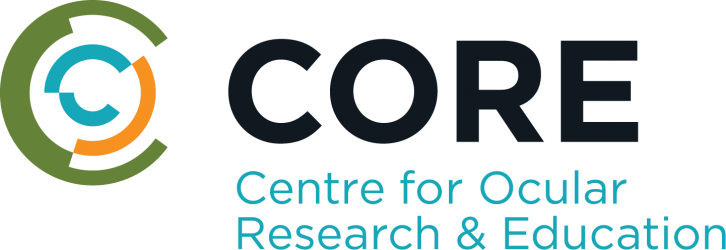Jump to:
Peer-reviewed articles
2025
Darge,H., Phan,C.M., Ng,A., Ho,B., Wulff,D., Hui,A., Jones,L.
Development of an Eye Model Using 3D-Printing for Correlating Measured Intraocular Pressure with Actual Internal Pressure
Current Eye Research 2025;Online ahead of print
[ Show Abstract ]
Purpose: The aim of this study was to develop a 3D-printed eye model to simulate measuring intraocular pressure (IOP) as a training device, and to assess the correlation between measured IOP using common clinical techniques and actual internal pressure.
Methods: The IOP eye model was designed using CAD software and printed with a resin stereolithography (SLA) 3D-printer (Formlabs 3B, Formlabs Inc., MA, USA). Two clinical instruments, Tono-pen (Tono-Pen AVIA, Reichert Ophthalmic Instruments, USA), and Perkins hand-held tonometer (Clement Clarke Perkins Tonometer Mk2, Vision Equipment Inc., USA) were used for IOP measurements of the model. The pressure within the model was adjusted between 7 to 55 mmHg at 5 mmHg increments, and the IOP values of the tonometry were correlated to the internal pressure displayed on the gauge.
Results: The IOP model could reliably produce internal pressure from 0 to 56 mmHg. The results showed that the Tono-pen measurements above 7 mmHg were closely correlated to the internal pressure obtained from the pressure gauge (Pearson r = 0.99, p < 0.0001). However, aligning the mires and measuring IOP accurately with the Perkins device was challenging.
Conclusion: The 3D-printed eye model was able to strongly correlate IOP readings taken with a Tono-pen with internal pressure measured by a pressure gauge. The internal pressure of this model can be regulated and is envisioned as a potential model for practicing tonometry at different ranges of pressure.
Garg,P., Shokrollahi,P., Darge,H., Phan,C-M., Jones,L.
Controlled PVA Release from Chemical-Physical Interpenetrating Networks to Treat Dry Eyes
ACS Omega 2025;10(1):1249-1260
[ Show Abstract ]
Dry eye disease is becoming increasingly prevalent, and lubricating eye drops, a mainstay of its treatment, have a short duration of time on the ocular surface. Although there are various drug delivery methods to increase the ocular surface residence time of a topical lubricant, the main problem is the burst release from these delivery systems. To overcome this limitation, herein, a chemical–physical interpenetrating network (IPN) was fabricated to take control over the release of poly(vinyl alcohol) (PVA), a well-known therapeutic agent used to stabilize tear film, from gelatin methacrylate (GelMA) hydrogels. In this report, PVA was specifically used as part of a GelMA-based polymeric hydrogel owing to its physical cross-linking ability via a simple freeze-thaw method. The interpenetrating polymer network was fabricated in a sequential manner where GelMA was chemically cross-linked by photo-cross-linking, followed by physical cross-linking of PVA using a relatively short freeze-thaw cycle. Interestingly, upon applying only one short freeze-thaw cycle (of 1 or 2 h), the crystalline domains in PVA were increased in the interpenetrating network. The endothermic peaks at 48 and 60 °C in differential scanning calorimetry (DSC) thermograms and 20°–2θ peaks in X-ray diffraction (XRD) patterns suggest the presence of these crystalline domains. With the help of a suite of characterization, we further delineate the role of freeze-thaw cycles in taking control over the release of PVA. The release profiles of the PVA-containing hydrogels showed highest linearity with the Korsmeyer–Peppas model (0.9944 < R2 < 0.9952), indicating that these systems follow non-Fickian or anomalous transport.
Garg,P., Shokrollahi,P., Darge,H., Phan,C-M., Jones,L.
3D-Printed Contact Lenses to Release Polyvinyl Alcohol as a Therapeutic Agent for the Treatment of Dry Eyes
Pharmaceutics 2025;17(2):Article 219
[ Show Abstract ]
Purpose: Dry eye disease is highly prevalent, and the most common treatment, lubricating eye drops, only remains effective for a very short period of time. This project aims to 3D print a proof-of-concept, custom-fit, polyvinyl alcohol (PVA)-eluting contact lens (CL) for the treatment of dry eye disease. PVA is a commonly used viscosity enhancer in eye drops, with the capability of reducing symptoms of dry eye by stabilizing the tear film and reducing tear evaporation. The protective effects of PVA could be attributed to its water-retaining ability, which provides moisturization and prevents the loss of water.
Method: In this work, a low-cost stereolithography-based 3D printer was retrofitted with a humidity and temperature control kit to 3D print a PVA-loaded custom-fit CL. To evaluate the print quality of the 3D-printed CL, circularity was used to evaluate the shape fidelity in 3D printing. The PVA release from these lenses was assessed, along with its role in acting as a viscosity enhancer. The effect of PVA was further analyzed by a dry eye disease (desiccation stress) cell model.
Results: The shape fidelity evaluation of the 3D-printed CL displayed excellent circularity. The diameter, sagittal depth, and base curve of the 3D-printed lenses were measured to be 14.27 ± 0.06 mm, 3.77 ± 0.16 mm, and 6.4 ± 0.24 mm, respectively. The PVA release curves showed that approximately 1300 µg of PVA was released over the study duration of 24 h.
Conclusions: Overall, this work demonstrates that a 3D-printed PVA-eluting CL is a promising candidate for the treatment of dry eye.
2024
Darge,H., Addisu,K. D., Tsai,H-C., Birhan,Y. S., Hanurry,E. Y., Mekonnen,T. W., Gebrie,H. T., Arunagiri,V., Thankachan,D., Wu,T-Y., Chang,H-M., Huang,C-C., Wu,S-Y
Actively Targeting Redox-Responsive Multifunctional Micelles for Synergistic Chemotherapy of Cancer
ACS Omega 2024;9(32):34268-34280
[ Show Abstract ]
Stimuli-responsive polymeric micelles decorated with cancer biomarkers represent an optimal choice for drug delivery applications due to their ability to enhance therapeutic efficacy while mitigating adverse side effects. Accordingly, we synthesized a digoxin-modified novel multifunctional redox-responsive disulfide-linked poly(ethylene glycol-b-poly(lactic-co-glycolic acid) copolymer (Bi(Dig–PEG-PLGA)-S2) for the targeted and controlled release of doxorubicin (DOX) in cancer cells. Within the micellar aggregate, the disulfide bond confers redox responsiveness, while the presence of the digoxin moiety acts as a targeting agent and chemosensitizer for DOX. Upon self-assembly in aqueous solution, Bi(Dig–PEG-PLGA)-S2 formed uniformly distributed spherical micelles with a hydrodynamic diameter (Dh) of 58.36 ± 0.78 nm and a zeta potential of −24.71 ± 1.01 mV. The micelles exhibited desirable serum and colloidal stability with a substantial drug loading capacity (DLC) of 6.26% and an encapsulation efficiency (EE) of 83.23%. In addition, the release of DOX demonstrated the redox-responsive behavior of the micelles, with approximately 89.41 ± 6.09 and 79.64 ± 6.68% of DOX diffusing from DOX@Bi(Dig–PEG-PLGA)-S2 in the presence of 10 mM GSH and 0.1 mM H2O2, respectively, over 96 h. Therefore, in HeLa cell lines, DOX@Bi(Dig–PEG-PLGA)-S2 showed enhanced intracellular accumulation and subsequent apoptotic effects, attributed to the targeting ability and chemosensitization potential of digoxin. Hence, these findings underscore the promising characteristics of Bi(Dig–PEG-PLGA)-S2 as a multifunctional drug delivery vehicle for cancer treatment.
Wu,T.-Y., Huang,C.-C., Tsai,H.C., Lon,T.-K., Chen,P.-Y., Darge,H. F., Hong,Z.-X., Ham,H.-J., Lin,S.-Z., Lai,J.-Y., Chen,Y.-S.
Mucin-mediated mucosal retention via end-terminal modified Pluronic F127-based hydrogel to increase drug accumulation in the lungs
Biomaterials Advances 2024;Jan(156):213722
[ Show Abstract ]
Noninvasive lung drug delivery is critical for treating respiratory diseases. Pluronic-based copolymers have been used as multifunctional materials for medical and biological applications. However, the Pluronic F127-based hydrogel is rapidly degraded, adversely affecting the mechanical stability for prolonged drug release. Therefore, this study designed two thermosensitive copolymers by modifying the Pluronic F127 terminal groups with carboxyl (ADF127) or amine groups (EDF127) to improve the viscosity and storage modulus of drug formulations. β-alanine and ethylenediamine were conjugated at the terminal of Pluronic F127 using a two-step acetylation process, and the final copolymers were characterized using 1H nuclear magnetic resonance (1H NMR) and Fourier-transform infrared spectra. According to the 1H NMR spectra, Pluronic F127 was functionalized to form ADF127 and EDF127 with 85 % and 71 % functionalization degrees, respectively. Rheological studies revealed that the ADF127 (15 wt%) and EDF127 (15 wt%) viscosities increased from 1480 Pa.s (Pluronic F127) to 1700 Pa.s and 1800 Pa.s, respectively. Furthermore, the elastic modulus of ADF127 and EDF127 increased, compared with that of native Pluronic F127 with the addition of 5 % mucin, particularly for ADF127, thereby signifying the stronger adhesive nature of ADF127 and EDF127 with mucin. Additionally, ADF127 and EDF127 exhibited a decreased gelation temperature, decreasing from 33 °C (Pluronic F127 at 15 wt%) to 24 °C. Notably, the in vitro ADF127 and EDF127 drug release was prolonged (95 %; 48 h) by the hydrogel encapsulation of the liposome-Bdph combined with mucin, and the intermolecular hydrogen bonding between the mucin and the hydrogel increased the retention time and stiffness of the hydrogels. Furthermore, ADF127 and EDF127 incubated with NIH-3T3 cells exhibited biocompatibility within 2 mg/mL, compared with Pluronic F127. The nasal administration method was used to examine the biodistribution of the modified hydrogel carrying liposomes or exosomes with fluorescence using the IVIS system. Drug accumulation in the lungs decreased in the following order: ADF127 > EDF127 > liposomes or exosomes alone. These results indicated that the carboxyl group-modified Pluronic F127 enabled well-distributed drug accumulation in the lungs, which is beneficial for intranasal administration routes in treating diseases such as lung fibrosis.
Professional Publications
2025
Darge H. Fast Forward to the Future: Engineering Vision Contact Lens Spectrum 2025;40, 3 April:





